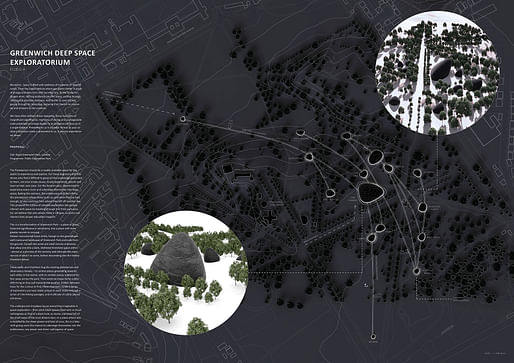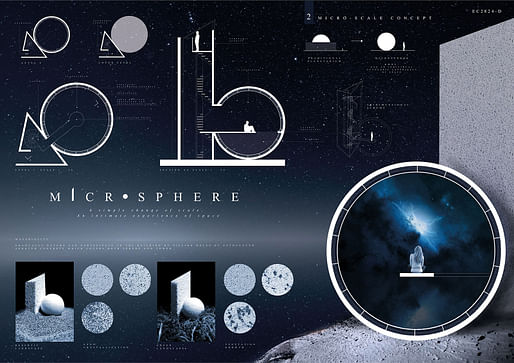
No smaller subject than the cosmos itself stood at the center of Eleven Magazine's sixth and recently concluded ideas competition — well, make that the architecture of cosmos observation, or the planetarium in particular. The challenge asked participants to rethink the typology of planetariums, considering technological advances and how architecture and design could 'play a more central role in the experience of space,' as the brief puts it.
After jury deliberation and online public voting, the entry "Greenwich Deep Space Exploratorium" by a joint UK/Singapore-based team emerged victoriously — taking home the First Prize as well as People's Choice Award.
Find the two top-winning submissions below and the six Honorable Mentions in the image gallery.
Winner and People’s Choice Award:
GREENWICH DEEP SPACE EXPLORATORIUM
by Jonathan Law, Cheryl Lim & Ashirai Zeyn Musikavanhu (UK / Singapore)

Project excerpt: "[...] This is a transformation of Greenwich Park – a place of great historical significance in astronomy, into a place with even greater secrets to conceal. Sixteen monumental black shells, foreign to the genteel and well-manicured landscape of Greenwich Park protrude from the ground. Carved into some are small circular entrances, that allow one into a dark, sheltered threshold space within – almost as a preview of the serenity and otherworldly experiences of what’s to come, before descending into the hollow chambers below. These shells and chambers hug the existing planetarium and observatory loosely – its central pieces gravitating towards each other in the centre, with its smaller pieces scattered further away across the park. Their external shape-forms subtly deforming as they pull towards one another. Hidden between trees for the curious to find, these chambers curate a series of exploratory journeys made unique to each visitor through a series of interlinking passages, and multitude of subtly placed entrances. [...]" — full text
Runner-Up:
MICROSPHERE
by Christian Gabbiani & Elisa Porro (Italy)

Project excerpt: "[...] The project is based on a network of little planetariums scattered all over the world. Every planetarium corresponds to a sphere with limited dimensions (5 m x 5 m) and its localization is absolutely not casual. In fact, micro-spheres are located next to the most important astronomic observation points in the world: starting from primitive constructions until contemporary observatories. This choice produces many advantages. First of all observatories and ancient buildings have usually a provision of services for visitors that makes our microspheres free from any activity different from pure experience of space. Additionally, astronomic observation points are essentially for network’s definition. Every observatory for example could capture pictures and videos to share them in live stream with its microsphere. Meanwhile, in ancient observation sites (where there are no telescopes), it’s possible to capture images of the sky and of astronomical phenomena, seen from the Earth without any instrument. Then, all this images could be transmitted to other microspheres thanks to virtual connection, defining an international network and an extreme variety of possible projections. Finally, why not think about expanding the network beyond the Earth? Maybe including images taken from spatial stations or from other planets [...]" — full text
Be sure to also check out the Honorable Mentions in the image gallery below. Click here to view the winning proposals in full.
All images courtesy of Eleven Magazine.

Pape Info Point
Register by Tue, Nov 19, 2024
Submit by Wed, Dec 18, 2024

Peja Culture Pavilion
Register by Wed, Dec 11, 2024
Submit by Tue, Jan 28, 2025

Architecture at Zero Competition 2024
Register/Submit by Mon, Dec 16, 2024

2025 Concrete Masonry Competition
Register by Wed, Apr 9, 2025
Submit by Wed, Jun 4, 2025
No Comments